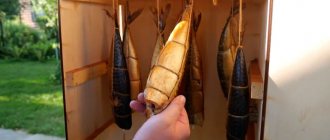Not only avid fishermen, but also simply lovers of fish products try to store dried fish at home so that it is always on hand. However, not everyone knows how to properly preserve fish at home. We will talk about storage features in this article.
Even a large catch can be prepared for future use and stored at home
Is storing dried fish different from dried fish?
Before answering this question, it’s worth understanding exactly how dried fish differs from dried fish. Each variety has its own preparation rules and storage requirements.
The differences between varieties are presented in the table.
| Dried | Dried |
| It can be either fresh or salty. | It only comes in salty form. |
| It can be prepared both in air and in the oven. | Dry only in the fresh air. |
| Cooking time in the oven takes only 5–6 hours, and in the air from 40 to 60 days. | Production time is 14–21 days. |
| Cooked without salt requires additional processing. | Immediately ready to eat. |
| Fatty varieties. | Lenten varieties. |
Rules for storing dried fish
Before storing the product, make sure that its quality meets the freshness criteria. An unpleasant odor or fungus on the surface will help you understand that the product is stale.
Storage conditions:
- do not expose the product to sunlight;
- the temperature in the storage area should not exceed +10 degrees, otherwise the fish will quickly deteriorate;
- do not let the carcasses dry out, the optimal humidity is 70–80%.
Under what conditions can dried fish be stored?
You can keep dried fish in suitable conditions from 1 week to 12 months. In this case, observe the main storage criteria:
- keep the product in a dark place;
- provide containers with carcasses with sufficient ventilation;
- adjust the humidity level in the room to 60–70%;
- Monitor the temperature, ideally if the temperature at the storage location is 3–10 degrees.
Please note that for best preservation, it is better to pack dried varieties before storage.
Shelf life
The duration of storage directly depends on the chosen location, available packaging and the microclimate of the room.
Shelf life of dried fish:
- without packaging at +25° – 2 weeks;
- in the refrigerator – up to 4 months;
- in the cellar, on the balcony at 0...+10 - 6 months;
- in the freezer – 1 year;
- in a vacuum jar – 9-12 months.
Shelf life of dried fish:
- at room temperature – 3-4 weeks;
- in the refrigerator – 6 months;
- in the freezer – up to 2 years;
- on the balcony, in the basement – 6-10 months;
- in a vacuum, alcohol jar – 1 year.
How and where to store dried fish at home
Taking into account simple storage recommendations, you can decide on the place where the fish will be stored. At home, you can choose several options that fit these criteria.
Suspended
You can keep carcasses hanging in a barn, pantry or attic. To prevent the product from drying out, first wrap it in baking paper. Wrap large varieties separately, and small ones - several pieces at a time. Hang supplies on string or hooks. In this form, the fish can remain fresh for 4 to 6 months. You don’t have to pack the product, but simply hang the fish at a distance of 3–5 cm from each other and cover with gauze.
Before eating, to protect yourself, check the quality of the fish.
Vacuum packed
It is not recommended to place dried fish in a plastic bag, as condensation will collect inside and the carcass will become moldy over time.
An analogue of such storage will be vacuum packaging. Moisture will not collect inside due to the lack of oxygen, and the fish will last for at least several months, provided that it is kept in the refrigerator. Please note that fattier and less salty varieties will last less than leaner and saltier ones.
In a glass jar or container
The method works similarly to a vacuum, but does not require additional equipment. You will need any glass container with an airtight lid and a regular candle.
Procedure:
- If the fish is large, cut it into pieces.
- Place a little salt at the bottom of the container.
- Place the carcasses in the jar not too tightly.
- Place a lit candle in the center of the container.
- Screw the jar tightly.
- All oxygen remaining in the container will burn, and a vacuum will form inside.
- Place the container with the product in the refrigerator.
This storage option will help keep the fish fresh for about 12 months.
In a refrigerator
The refrigerator is the most suitable environment for storing dried fish. The optimal temperature regime is maintained here. The best place is the bottom shelf or vegetable drawer. To prevent other foods from absorbing the fishy smell, wrap the carcasses in baking paper. This way you can keep fish fresh for 6 months. The main thing is not to put the product in a plastic bag or leave it without wrapper at all.
In the freezer
Dried fish can last in the freezer for as long as possible, at least a year. Before putting the product in the freezer, portion it out so that you can only remove one portion from the freezer as needed. Before use, keep the carcasses in the room for 15–30 minutes.
In tin cans
This storage method has one significant disadvantage. Not everyone has a tin container with a tight lid of the required large size in their home. If you do have such a container, you can safely use it. Place all the carcasses in a jar. Cover tightly and place in the refrigerator. An airtight container will not allow excess oxygen to get inside, will protect it from sunlight and will not allow the fish to permeate the rest of the food in the refrigerator with a specific smell.
In foil
Foil does not allow air to circulate, which has a very bad effect on the quality of dried fish. Even after a short period of storage, carcasses can become moldy. It is strictly not recommended to wrap the product tightly in foil. If there is no other material where you can wrap the carcasses, make several holes in the foil with a fork or knife. This way you will provide the product with the necessary air circulation.
In a box or canvas bag
It is convenient to place dried fish in a box or canvas bag in a basement or closet. Wrap a basket or wooden box with natural fabric. Place a layer of fish and cover with tracing paper. Fill the entire container, covering each row with paper. Cover the top of the container with a cloth. The product can remain in this form for 3 to 6 months.
In brine
Prepare a strong salt solution. Cut large fish into portions, and remove the tails from small fish. Place the carcasses in a container and fill with brine. Close the container with a lid and place it in a cool place. Before use, soak the required number of carcasses and dry to the desired consistency.
In a cellar or closet
A cellar or basement is ideal for storing dried fish. Here the required temperature and humidity levels are fully observed, and there is no light. You can simply hang the carcasses on hooks or a rope, having previously packed them in paper or put them in a box covered with gauze or in a fabric bag.
On the balcony
For such purposes, a glazed balcony on the north side is suitable. The best option would be to pack the carcasses in baking paper and hang them on a rope. This way you will maintain the freshness of the product for 3 months.
On air
This storage method is suitable if you want to use the product within 3-4 weeks. After a month, the fish may lose freshness or turn from dried to dry. Hang the carcasses on ropes or hooks so that they are not exposed to sunlight. To protect them from insects, cover the bundle with gauze or pack it in a cotton bag.
Storing dried fish with vodka
Vodka kills harmful microorganisms and maintains the required level of humidity in the storage container. Using this method is very simple. Select a container with a tight lid of the required size and pour 50 g of vodka into the bottom. Place the carcasses in a container and close. Keep the jar or container of fish in a cool place away from sunlight.
In a glass jar
Three-liter jars need to be thoroughly washed and sterilized. When they dry, fish are placed in them. Airless storage involves removing oxygen from the can.
- When the carcasses are tightly packed into the jar, a candle is placed there and set on fire.
- Then the jar is sealed with a lid.
- After there is no oxygen left in the jar (it will burn out), the fire will go out and a vacuum will form inside the jar, which will allow the fish to be stored for about 1 year.
- This happens because the harmful bacteria that cause rotting are unable to exist without oxygen.
How to keep dried fish from flies
Since one of the stages of preparing dried fish involves drying it outside, during the warm season the issue of controlling flies is very relevant. They can literally spoil the product in a matter of minutes by depositing larvae inside. Fishermen and fans of fish delicacies have come up with a lot of ways to combat insects. The most popular fly repellents include:
- box;
- bag or gauze;
- special mixture;
- umbrella.
The easiest and most effective way is to use gauze or a mosquito net. There are 2 main rules here:
- to prevent the fly from getting inside, close or sew all the cracks tightly;
- do not allow the gauze to touch the carcasses, otherwise the insect will cause harm through the material (wooden spacers are usually used for this).
An umbrella in tandem with gauze will make an excellent drying chamber. First, sew a rectangular gauze cover, the diameter of which will be equal to the diameter of the umbrella when open. Sew the cover to the edge of the umbrella to create a gauze veil. At the bottom of the case, 30 cm from the edge, attach a wire ring. Hang the umbrella in the storage area, and hang the carcasses on its rods inside. Tie the lower end of the cover with a strong knot.
In a similar way, you can also make a box, the frame of which is made of wooden blocks, and the walls of gauze or mosquito net.
You can also dip the carcasses into a solution of vinegar and sunflower oil in a ratio of 6:4 before hanging. If you cover your fish with the mixture every day, the flies won't even come close to the product.
Fridge
The roach should be stored in the refrigerator in its packaged form. The fish is individually wrapped in paper and placed in the vegetable compartment. There it can be preserved for up to 2 months, unless friends come to visit with beer first.
A refrigerator with an additional compartment (0°C) is best suited for this product. At zero temperature, the excellent taste and aroma of fish will last up to 6 months.
How to preserve dried fish in the heat or on the train
Before a long trip in the hot season, take care of how you will store dried fish. You can preserve the freshness of the product for 3-4 days by freezing. First, place the carcasses in the freezer and wait until they are completely frozen. Then wrap it in foil or put it in a thermal bag.
Place the fish in a storage container and cover it with plastic containers with ice.
You can replace such containers with improvised means. For example, fill a clean baby diaper with water and freeze it. When the liquid turns into ice, wrap the carcasses in diaper and pack.
Freezing
Whether roach can be stored in the freezer is of concern to those who have significant reserves of the delicacy product on hand.
Freezing is a good way to preserve this fish for a long time.
Carcasses should be sorted by size and hermetically packaged. To do this, you can use film, paper or plastic bags.
In the freezer, vobla retains quality for up to 1 year, if you do not allow re-freezing. To use only the required amount of the product, it is divided into portions in advance.
What's the best way to store dried fish at home?
Before deciding how to store dried fish, determine its quality. If there is mold on the surface, an unpleasant odor emanates from the carcass, or even worse, worms have appeared inside, immediately get rid of the product. High-quality dry fish will be intact and without damage, its scales will be smooth and shiny, and the product will have a characteristic fishy smell.
In the freezer
Dried fish will last in the freezer for as long as possible – at least 12 months. To preserve the freshness and taste of the product, before putting it in the freezer, divide all the carcasses into portions and pack them in paper. This way you can take as many hazel grouse for consumption as you can eat at one time.
In a refrigerator
The best place for dried fish is the middle shelf of the refrigerator. Wrap the carcasses in paper before storing. This way you will better preserve its freshness and protect other products from the fishy smell. The batter can last no more than 6 months in the refrigerator.
In boxes or jars
The main criteria for this storage method are optimal temperature and humidity. You can ensure such conditions by placing the container with the battering ram in the refrigerator, basement or closet. Like dried fish, you can place dried fish in a glass container and tightly close the lid, removing the oxygen inside with a burning candle. You can also put the carcasses in a wooden or cardboard box with holes for ventilation.
How to store different varieties of dried fish
Flounder, bream, ide or roach will remain fresh during short-term storage of up to 30 days if the following are observed:
- temperature range: from +3 to +8 degrees;
- optimal humidity equal to 65–80%;
- packaging standards (paper or fabric, but not polyethylene);
- light regime, or, to be more precise, its absence.
Please note that a low level of humidity will cause the carcasses to dry out, and a high level will cause mold to appear on their surface.
For long-term storage of roach, bream, ide or flounder, use vacuum packaging, glass containers or a tin can. Keep the container with the product on the middle shelf of the refrigerator. For longer storage, you can put the carcasses in a box and put them in the cellar, or package them and place them in the freezer.
How long can dried fish be stored?
The period during which dried fish will definitely not lose freshness is determined by the nature of the conditions of the environment where it is located. For example, carcasses will be stored:
- in the freezer - at least 12 months;
- in the refrigerator - no more than 6 months;
- in a jar in a cool, dark place – about 12 months;
- in a box in a basement or cellar - approximately 8 months.
The specified periods can be significantly reduced if at least one of the storage conditions is violated.
In the freezer
Freezing allows dried fish to retain its taste for about 1 year.
The supplies are divided into parts, each carcass is wrapped in paper as tightly as possible, and then placed in bags. As much air as possible is expelled from the bags, after which they are sealed or sealed. Storing dried fish in the freezer in a bag without paper will damage the packaging due to sharp fins. After this, the fish will begin to lose moisture, freeze and acquire a bitter taste.
Defrosting should occur at room temperature, without the use of a microwave or hot air. When the carcasses are thawed, they are hung in places with good ventilation and dried for several hours.
How to tell if fish has gone bad
The first sign of fish spoilage, which is difficult to miss, is an unpleasant odor. In addition, there are other signs by which you can determine that the product has gone bad, namely:
- scales are unattractive and sticky;
- pressing on the meat leaves a dent;
- The integrity of the carcass is compromised, the meat falls between the bones.
If you detect at least one sign, do not even risk trying the product. It’s better to immediately throw the spoiled carcass in the trash.
General information
Dried fish stores well in a cool, dry place, such as a basement, attic or pantry. Before storing, fish should be sorted by size. Small copies can be wrapped in paper several pieces at a time, and large ones can be wrapped one at a time. The fish are hung on hooks and left for storage in a room with a temperature of 10 0C and a relative humidity of 80%. In this case, the storage period is 4 months, if the room is regularly ventilated.
How to properly store dried and dried fish
There are various ways to store roach, bream and other fish at home. For example, for transporting fish on a train, the short-term storage method is used; for long-term storage in an apartment, the principle of long-term storage is used.
REFERENCE! It is equally important to observe the shelf life of fish so that it can remain tasty and not dry out.
Method for short-term storage
Dried fish can be stored at room temperature without packaging for up to a week. If you leave it for a longer period, the fish will dry out. Therefore, if you need to store fish for more than a week, then you need to wrap it in paper or put it in a cardboard box. It should be stored under certain conditions considered optimal:
— air temperature — no higher than 8 0С;
— humidity — from 65 to 80%.
To save space, you can cut off the fins from the fish. The fish should be wrapped in paper so that the fat contained in it does not oxidize. In addition, the wrapper will help the fish not dry out.
How to properly store dried fish in a store
Of course, the freshness and quality of dried fish is also affected by how it was stored before you bought it. If the level of humidity and temperature was not maintained or the carcasses hung in the sun for a long time, their freshness will definitely not be preserved.
Storage temperature in refrigerated display case
First of all, please note that fish products must be kept in a separate refrigerated display case. The unit must be set to the temperature regime that is suitable according to GOST standards. This document states that without packaging, dried fish must be kept at a temperature from 0 to +8 degrees, and in film bags at a temperature from -18 to 0 degrees.
Choosing the right fish
If the dried fish to be stored is not prepared yourself, but purchased in a store or market, it is recommended to carefully inspect it. The carcass should be even in color, without yellow spots and very dry areas with salt coming out.
Interesting! In southern Russia, all dried and salted fish are checked for freshness by piercing its belly with a long thin needle. If at the same time a putrid smell appears, it means that the delicacy has begun to deteriorate. It is not stored, but thrown away.
It is difficult to store a carcass that is not sufficiently dried . It may be too oily or moist. This is especially true for lean fish, such as pike perch.
How to store dried fish in production
In factories where fish are salted, dried and dried, carcasses are stored in special cardboard or wooden boxes, wicker baskets, bags or paper. In production, storing the product in polyethylene or foil is not allowed.
Fresh dried fish is truly a tasty and quite healthy product. You can preserve its freshness for as long as possible in several ways. Choose a storage method depending on the number of carcasses, the method of their preparation, the conditions of the apartment and your own preferences.
Method 1: box
Let's look at how to store a battering ram at home if you have a dark, cool pantry or dry basement.
Step 1. Prepare everything you need to store dried fish
|
Step 2: Lay down the first layer
|
Step 3: Add Another Layer
|
| Step 4. Lay the fish in tiers to the top Continue working, alternating layers of product and newspaper in 2-3 layers |
Step 5: Cover the top layer with newspapers
|
Step 6. Put the container into storage
|











